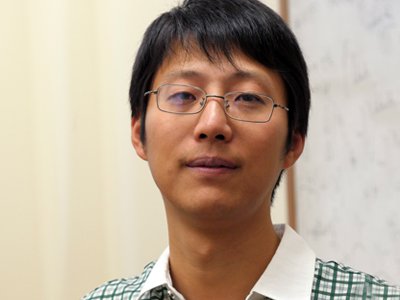Mathematician Lauded for Contributions to Complex Geometry
Yuan Yuan receives Simons Foundation Grant, invited to lecture at international conference

Syracuse University mathematics assistant professor Yuan Yuan has recently been recognized for his work on complex geometry with both a Simons Collaboration Grant and an invitation to speak at a prestigious conference, the International Congress of Chinese Mathematicians (ICCM).
The geometry you may have learned in high school describes three-dimensional objects that can be observed in the world we live in. Complex geometry can further be used to explain abstract phenomena in physics, Yuan says. “It has been used in string theory and quantum field theory in order to describe elementary particles for physicists.”
Yuan was invited to the seventh ICCM to present his work on holomorphic isometries, a subclass of holomorphic maps, which describe the relationship between two spaces while preserving complex geometric structure as well as the measurement of distances.
The triennial ICCM brings together illustrious Chinese mathematicians from all over the world to discuss advances in pure and applied math. This year’s conference included over 1,500 attendees. “The invited speakers in ICCM are leaders in their fields—their names include most of the well-established Chinese mathematicians across many subfields,” Yuan says. “It is a very big honor to give an invited lecture at this event.”
A Simons Collaboration Grant from the Simons Foundation, a funder of basic sciences and mathematics, will support Yuan in furthering his research. The $35,000 grant will support five years of investigation on the rigidity of holomorphic maps and complex Monge-Ampère equations. Both of these areas have implications in additional fields of mathematics and physics.
In physics, rigidity describes the property of an object to resist to being bent or deformed. Yuan will be looking at a similar property in complex geometry. “It is of great interest to understand the algebraic and differential geometric structure of Hermitian symmetric spaces, which serve as basic models not only in differential and algebraic geometry, but in mathematical physics, number theory and other fields,” he says.
Similarly, the geometric objects admitting solutions to classes of complex Monge-Ampère equations can serve as models of extra dimensions of spacetime in superstring theory in physics.
“These equations are indispensable tools to study various canonical Kähler metrics and formation of singularities on the complex algebraic manifolds, which not only reveals the mysteries of deep, unified and fundamental intrinsic structures in mathematics, but also plays a crucial role in understanding physical laws,” Yuan says.
